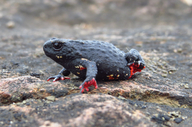|
Melanophryniscus atroluteus (Miranda-Ribeiro, 1920)
| family: Bufonidae genus: Melanophryniscus |
 © 2015 Paul Szekely (1 of 4) |
|
|
|
Description Distribution and Habitat Country distribution from AmphibiaWeb's database: Argentina, Brazil, Paraguay, Uruguay
Life History, Abundance, Activity, and Special Behaviors Trends and Threats Possible reasons for amphibian decline General habitat alteration and loss
References
Achaval, F., and Olmos, A. (2003). Anfibios y reptiles del Uruguay Ed. Graphis. Serie Fauna N°, Montevideo, Uruguay. Klappenbach, M. A., and Langone, J. A. (1992). ''Lista sistemática y sinonímica de los anfibios del Uruguay con comentarios y notas sobre su distribución.'' Anales del Museo Nacional de Historia Natural de Montevideo (2a Serie), 8, 163-222. Kwet, A., Maneyro, R., Zillikens, A., and Mebs, D. (2005). ''Advertisement calls of Melanophryniscus dorsalis (Mertens, 1933) and M. montevidensis (Philippi, 1902), two parapatric species from southern Brazil and Uruguay, with comments on morphological variation in the Melanophryniscus stelzneri group (Anura: Bufonidae).'' Salamandra, 41(1/2), 1-18. Kwet, A., and Miranda, T. (2001). ''Zur Biologie und Taxonomie der Swarzkrote Melanophryniscus atroluteus (Miranda-Ribeiro, 1920).'' Herpetofauna, 23, 19-27. Langone, J. A. (1994). Ranas y sapos del Uruguay (reconocimientos y aspectos biológicos). Museo Damaso Antonio Larrañaga 5, Serie de Divulgación Maneyro, R., Forni, F., and Santos, M. (1995). Anfibios del Departamento de Rocha. Serie Divulgación Técnica 1 (PROBIDES), Rocha, Uruguay. Maneyro, R., and Langone, J. A. (2001). ''Categorización de los anfibios del Uruguay.'' Cuadernos de Herpetología, 15(2), 107-118. Miranda-Ribeiro, A. (1920). ''Os Brachycephalideos do Museu Paulista (com tres especies novas).'' Revista do Museu Paulista, 12, 305-313. Núñez, D., Maneyro, R., Langone, J. A. and De Sá, R. O. (2004). ''Distribución geográfica de la fauna de anfibios del Uruguay.'' Smithsonian Herpetological Information Series, 134, 1-34. Originally submitted by: Raúl Maneyro (first posted 2006-08-04) Edited by: David Wake (2006-08-04) Species Account Citation: AmphibiaWeb 2006 Melanophryniscus atroluteus <https://amphibiaweb.org/species/341> University of California, Berkeley, CA, USA. Accessed Jan 17, 2025.
Feedback or comments about this page.
Citation: AmphibiaWeb. 2025. <https://amphibiaweb.org> University of California, Berkeley, CA, USA. Accessed 17 Jan 2025. AmphibiaWeb's policy on data use. |


 Map of Life
Map of Life